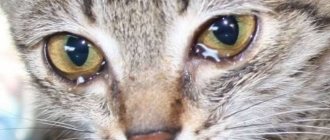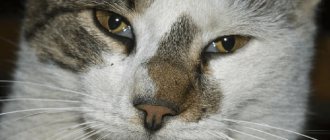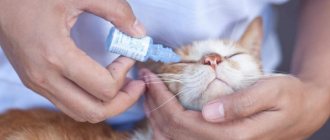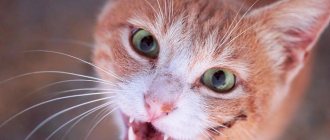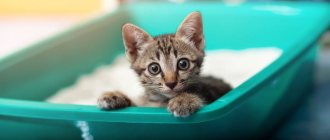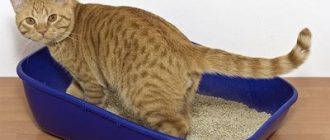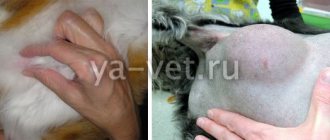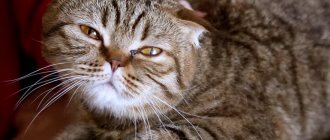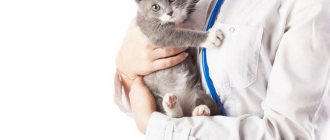The reasons why a white film appears on a cat's eyes can be varied. If, in addition to the appearance of a film, there are other pathological symptoms in the inner corners of the eyes, such as inflammation, redness, swelling and tearing, it is better not to delay a visit to the doctor and find out the exact diagnosis as soon as possible. If necessary, the doctor will prescribe treatment. If you follow all the recommendations and advice of the veterinarian, within a few days the pet will be healthy.
Preventive actions
To prevent the cat from developing an eyesore, you should systematically examine the animal’s visual organs.
It is important to normalize your pet’s diet by adding a sufficient amount of vitamins and microelements. In addition, veterinarians recommend giving special cat vitamins from time to time.
It is important for owners to take care of creating a safe environment for their cat to live in and protect it from various injuries. If the pathology has already been diagnosed, it is important to start treatment immediately and follow all the veterinarian’s recommendations. It is recommended to place the animal in a separate room where there are no sharp objects that it can hit.
If you have leukoma on the visual organs, you should not let your pet outside unattended
It is also important to keep it away from stray animals, as they may be infected. It is forbidden to carry out independent treatment and use for a cat those medications that were prescribed to a person.
This precaution is due to the fact that medications may not only not cope with the disease, but also cause serious adverse reactions in the cat. https://www.youtube.com/embed/9K1zzBOdnOI
Third eyelid
This disease, in which a cat's eyes are half closed with a film, is conventionally called the third eyelid. The film that appears on the outside of the eyeball can cover most of its surface. In addition to external signs, the third eyelid also affects the behavior of the cat.
Film on eyes
The pet owner may notice previously uncharacteristic habits:
- Constant blinking and squinting of the eye due to increasing discomfort.
- The cat hides from bright lighting, especially artificial light.
- The pet rubs its muzzle with its paws, most often the eye area.
Additional external signs include increased tearing of the eyes, suppuration and swelling of the mucous membrane, as well as a rapid decline in the pet’s visual acuity. Inaction in the event of such a phenomenon is very dangerous and can lead to complete blindness of the cat.
For old cats, such a symptom is not evidence of pathological processes. However, you cannot do without the help of a veterinarian.
Why does prolapse develop?
When a cat's eyes are half covered with a film, they speak of prolapse of the third eyelid. In this case, the cat feels discomfort and his vision gradually deteriorates, up to its complete loss. The reason for the development of this degree of disease may be associated with pathology of the organ of vision itself, as well as with diseases of the nervous system or gastrointestinal tract, reduced immunity of the pet, or with a fracture of the nictitating membrane as the kitten grows older.
Some cat breeds even have a genetic predisposition to third eyelid prolapse, which often occurs within the first year of life. And due to the hypertrophy of the nictitating film, it constantly rubs against the cornea, irritating the mucous membrane of the latter. At the same time, kittens with such an injury begin to rub their faces, wanting to get rid of the unpleasant sensation.
The film on the eyes of cats is often associated with inflammation, when the membrane becomes swollen, its hyperemia and prolapse develop. All this causes discomfort to the pet, and he washes himself more often.
Prolapse also develops during burns with aggressive chemicals or thermal burns, which injure not only the conjunctiva, but also the cornea of the eye. The affected tissues are swollen, reddened, lacrimation is observed and the cat feels a burning sensation and severe pain in the eyes. He begins to behave restlessly, shaking his head and rubbing his muzzle. The most dangerous burns are those of chemical origin, since they often injure deep-lying tissues and are complicated by bacterial infection.
The peculiarity of burns is that the severity of the injury can be assessed only on the second or third day from the moment it was received . Most often only one eye is affected.
If a kitten's cartilage tissue develops incorrectly, a fracture of the nictitating membrane may occur that cannot be restored. In this case, the third eyelid loses its functional abilities.
© shutterstock
Prolapse of the third eyelid is also possible with rhinotracheitis, when the disease is in its initial stage or in a mild form. In this case, the kitten experiences rhinitis and a rise in body temperature, it becomes apathetic, eats poorly or refuses to eat at all.
Sometimes the cause of the pathology is a membrane adenoma, which looks like a pink or red growth in the corner of the eye, which gradually grows, covering the eye . In this case, the cat experiences lacrimation, a rise in temperature, a worsening general condition, it becomes aggressive and cannot completely close the affected eye.
Diagnostic measures
With such a pathology, the animal must undergo gonioscopy.
If owners notice that a cat has an eyesore, it is important to contact a veterinarian as soon as possible. The doctor will conduct a survey during which he will find out what the animal is fed and what pathologies it has suffered.
Taking an anamnesis helps to identify the cause that provoked the occurrence of a cataract. Then the doctor begins a visual examination of the pet’s visual organs and conducts tonometry, which makes it possible to detect intraocular pressure to confirm or refute the presence of cataracts and glaucoma. The cat is also sent for the following examinations:
- biochemical and general blood tests;
- serology;
- fluorescein test;
- gonioscopy.
Why does protrusion develop?
A protrusion can appear when a foreign body enters the eye or it is injured, for example, during a fight between cats. In this case, the disease is more often present in one eye, and the owner observes how the pet’s eye gradually becomes covered with a white film. At the same time, the pet develops a feeling of pain in the eye, pain and burning, which is why it rubs its muzzle with its paws to get rid of the irritant. If treatment is not started, there is a high probability of bacterial infection. In this case, purulent discharge appears from the eye, and the conjunctiva becomes red.
Often, the formation of a protrusion is observed with conjunctivitis, when clear clinical signs in the form of purulent discharge have not yet appeared. In this case, the conjunctiva of the cat’s eye becomes bright red and tearing is observed, and the corners of the eyes are covered with a film. At the same time, he has pain and itching in his eyes, the animal rubs his muzzle more often and behaves restlessly. The infection usually affects one eye, but when the cat washes itself, it transfers the disease from the affected eye to the healthy eye.
When a film appears on a cat’s eyes, the owner may think about the pathology of the nervous system. In this case, the protrusion is accompanied by a constricted pupil on the affected organ of vision, and a slightly pronounced drooping of the upper eyelid. This problem requires an urgent visit to the veterinarian, since it may be a manifestation of a serious pathology.
© shutterstock
If a cat has a film in the corners of his eyes, it is worth thinking about possible protrusion due to helminthic infestation. This symptom occurs not only in cases where the parasites are located directly in the eye, but also when they are in the intestines. In this case, the pet’s condition is disturbed, it quickly loses weight, does not eat well, diarrhea or vomiting begins, the body temperature rises and after a while the hair begins to deteriorate and fall out.
Obvious signs of the disease
If cats have watery eyes, formations on the eyes, or a thin white film, this is a clear sign of a serious illness. Also, an equally unpleasant eye disease in cats is the third eyelid, also called the nictitating membrane, which can cover most of the eye. This skin is usually located in cats only from the inner corner of the eyes. Due to inflammation and irritation of the eyes in cats, suppuration begins when a white or blue film appears on the eyes. This irritation can be greatly worsened when a foreign object enters the eye. If a white film appears on the kitten’s eyes, and the owners forgot to invite a professional veterinarian, then the disease may become more complicated and the cat may simply lose his sight.
These can be various infectious diseases, such as herpes virus or chlamydia. It must be taken into account that the disease must be identified in time and treatment must begin as soon as possible, thereby curing the pet’s eyes and prolonging its life.
Signs of the disease may be as follows:
- the cat rubs its eyes with its paw too often;
- the pet avoids bright light;
- the cat blinks too often;
- you noticed that the cat began to squint;
Features of albino kittens
In addition to their appearance, albino babies differ from their counterparts in their softer character and poor health. Their skin is very sensitive, so walking in direct sunlight can cause severe burns.
Appearance
Regular white cats and tomcats are often born with blue eyes, while albinos are born only with red ones. Due to the lack of pigment, their iris has no color, so all the vessels are clearly visible through it. They are what give the eyes a red-pink tint. In rare cases, there may be a subtle pale blue tint.
A pinkish tint can also be seen on the nose and paw pads. It is also explained by the play of light reflecting blood flow.
Health status
Due to numerous health problems, albino animals are not adapted to life in the wild. But with proper care and maintenance, all existing disorders do not affect their life expectancy.
Deafness
The statement that all albino cats are deaf is only partly true. Most often, deafness occurs in blue-eyed pets or animals with heterochromia. In the second case, the ear on the side of the blue eye is deaf. That is, deafness is inherent in partial albinos, and not complete ones.
Blindness
Poor vision is due to increased sensitivity to the sun. If you leave this point unattended, your pet will become completely blind due to the gradual burning of the iris by the sun's rays.
Weak immunity
Fragile albino cats catch colds easily and often suffer from allergic reactions. Keep them warm and vaccinate them promptly, as any infection can be fatal to them.
Character
A genetic anomaly does not affect the character, so the behavior of the animal is formed individually. Despite this, owners of pets with snow-white fur coats note their tenderness and sensitivity. Albino cats are strongly attached to their owners, but are rather cowardly and withdrawn in the presence of strangers. This may be due to poor health.
The nature of dark discharge from the eyes of cats
Brown discharge from the eyes is caused by the appearance of a specific pigment that is part of the tear, which can occur under the influence of various factors. Eye secretion can have different consistency and color. Based on these signs, it is possible to determine the cause of the appearance of pathological discharge from the eyes.
If the brown discharge is abundant, with admixtures of pus, bloody patches, most likely the cat has developed a bacterial infection that accompanies inflammatory processes (chlamydia, rhinotracheitis, calcivirosis, panleukopenia). Possible causes also include eye and ear diseases (conjunctivitis, uveitis, otitis).
If a cat's eyes run brown, dry dark crusts appear in the corners, epiphora (impaired functioning of the tear ducts) is most often diagnosed, which can be caused by various reasons and factors.
Dark brown, “red” tear ducts are detected in cats of light, white colors. If the flow is not abundant, within normal limits, there is no need to sound the alarm.
Causes of a cloudy film on the eye
The following factors can cause a cat to develop a film in the middle or corners of its eyes:
- Injury or presence of a foreign object in the eye;
- Infection (in such cases, most often both eyes are affected);
- Dehydration or weight loss;
- Oncology;
- Upper respiratory tract infections;
- Genetic predisposition (usually found in dogs, but can also occur in cats, especially inbreeding);
- Conjunctivitis of allergic origin;
- Adenoma or other benign formation;
- Parasites;
- Diseases of internal organs;
- Entropion of the eyelids (more common in Maine Coons, Britons, Persians and Scottish Folds). It is characterized by the manifestation of such signs as tearing, pain, visual reduction of the eye, wetness around the eye, redness, swelling of the cornea and a change in the shape of the eye section). Entropion can be complete or partial (only some part of the eyelid turns in) and is caused by constant contact of the cornea with the skin, fur and eyelashes. Mainly due to irritation and injury to the cornea, keratitis occurs and ulcers form.
If you see that the film covers half of only one eye, you can assume mechanical damage. If both are present, this may indicate a serious illness.
The “film,” or third eyelid, can cover one or both eyes at once, and this can reveal some signs of disease
Why does a cat have a film on its eyes?
The main reason for the appearance of a film on the eyes is suppuration, the appearance of formations in the eyes and tearing. If the eyelids are swollen and the film is bluish in color, then the cause of the problem is inflammation of the eyes. Here it is better to take the animal to a veterinary hospital, where, using an ophthalmoscope, the doctor will examine the eyes, determine the cause of the disease and offer high-quality effective treatment. If the cause of such a film on the eyes is strabismus, blocked ducts or cataracts, then the help of a surgeon is required. But if the main reason for the film is only the third eyelid, then this is a fairly common phenomenon.
Provoking factors
Prolapse of the third eyelid in a cat can occur for various reasons:
- allergic conjunctivitis;
- prolapse;
- fungal, viral, bacterial infections;
- abnormal growth of cartilage;
- foreign body;
- eye injuries;
- adenoma of the nictitating membrane;
- diseases of internal organs;
- endo- and ectoparasites in the animal’s body;
- flu;
- predisposition at the genetic level - prolapse of the third eyelid is common in Persian and British cats.
Photo of a cat's prolapsed third eyelid
Allergic conjunctivitis
Allergies in a pet can occur for various reasons: intolerance to one or more components of a new cat food, household chemicals, etc. The symptoms of the reaction are complex - in addition to discharge from their eyes, the cat may experience itching, redness and peeling of the skin, hair loss, otitis media .
When third eyelid prolapse is one of the manifestations of allergies, it is first necessary to identify and exclude the allergen. To do this, you will have to keep a diary of the pet’s food and general condition for some time, where you need to write down all the foods and other substances that the cat shows a reaction after contact with.
Prolapse
In cases where the lacrimal glands of the third eyelid lose their correct anatomical position and they fall out of the conjunctival sac, we are talking about prolapse. As a result of the pathology, a pinkish round formation is observed in the inner corner of the cat's eye. The process can cause swelling, inflammation and even necrosis.
Important! Inexperienced owners often confuse lacrimal gland prolapse with third eyelid adenoma. However, an adenoma is a benign neoplasm, and prolapse is only a loss of the correct location of the glands
Infectious lesions
Another possible cause of third eyelid prolapse is complications from infectious diseases, such as otitis media. The pathology occurs due to inflammation of the optic nerve. Sometimes the membrane can cover up to half of the eyeball. In such cases, a surgical operation is often performed - resection of the third eyelid.
Abnormal cartilage growth
As the kitten grows, sometimes the nictitating membrane breaks due to improper development of the cartilage. As a result, the third eyelid may become inflamed and fall out. It is impossible to correct the situation without antibiotic therapy and subsequent surgery.
Foreign body in the eye
At home, you can remove a foreign object from an animal’s eye by gently rinsing it with cotton swabs soaked in boiled water.
If washing does not bring results, you should show your pet to the veterinarian as soon as possible - he will remove the foreign body with special tweezers and prescribe therapy: eye drops and hydrocortisone ointment.
Mechanical eye damage
During games, hunting or as a result of a fight, a cat can get injured in the eyes. It is impossible to identify the damage on your own; it is better to show your pet to a doctor. The only possible first aid is to wash the eyes with a weak solution of furatsilin.
Adenoma of the third century
This benign neoplasm in the inner corner of the eye is often confused with inflammation or prolapse of the nictitating membrane.
The adenoma prevents the animal from closing its eyes normally, as a result of which microbes and dirt enter the mucous membrane, causing inflammatory processes.
Adenoma of the third eyelid is common in cats.
Internal pathologies
Diseases of the internal organs can also cause prolapse of the third eyelid. Adequate treatment and assistance in such cases are possible only after a correct diagnosis has been made. Without knowing which organ is damaged, there is no point in starting therapy - there will be no result.
Parasites
If, in addition to signs of prolapse of the nictitating membrane, the animal rubs its anus on the carpet, and symptoms such as lethargy and loss of appetite are observed, the pet most likely suffers from a parasitic infection.
A domestic cat can become infected with helminthiasis without even leaving the apartment: there is a possibility of larvae getting into the home along with a person’s shoes or clothing.
Flu
At the initial stage of influenza, your pet may experience eyelid prolapse. In addition, there may be an increase in temperature and suppuration in the eyeballs. You cannot delay treatment - the flu can lead to the death of your cat.
Allergic conjunctivitis
Attention! Attempts to straighten a cat's third eyelid on your own can lead to disastrous consequences, including removal of the eyeball!
What treatment is prescribed when the eye is covered with a white film?
It is important to treat the disease comprehensively, first eliminating the original source of the problem. If the squirrels swim due to a foreign object getting under the eyelids, you need to try to remove it without damaging the delicate mucous membrane. When exposed to chemicals, it is important to wash regularly until the inflammation goes away. If the eyes become covered with films as a result of bacterial conjunctivitis, antibacterial eye drops and ointments are prescribed.
An eye closed by the third eyelid may be a symptom of helminthic infestation. In this case, anthelmintic drugs are prescribed, which are taken strictly according to the regimen prescribed by the doctor. If a cat rolls back its third eyelid due to neurological disorders, therapy is based on the use of sedatives. To prevent bacterial complications, it is useful to rinse the mucous membrane daily with a solution of Furacilin or potassium permanganate. Sometimes the eye may become closed due to the development of a malignant tumor or adenoma. Then surgical treatment is performed to remove the pathological growth on the floor of the eye.
Folk remedies
A decoction of yarrow can be used to treat organs of vision affected by an infectious disease.
If your pet's eyes are covered with a white film due to the progression of the inflammatory infectious process, you can wash the mucous membrane with a decoction of chamomile, calendula, and yarrow. Olive oil has antiseptic properties and can be used to wipe your cat’s eyelids. But it is important to keep in mind that treatment with unconventional methods is carried out only with the permission of a doctor. After all, if a cat’s eyes roll constantly, it is better not to self-medicate, so as not to provoke complications.
Own diseases of the third century
There are a number of specific diseases of the nictitating membrane.
Prolapse (loss) of the lacrimal gland
Lacrimal gland prolapse is rare but occurs in brachycephalic cats. This often occurs during a period of active growth of the cat, at the same time the size of its eyes rapidly increases. The ligament that holds the lacrimal gland of the nictitating membrane in its normal place - under the conjunctiva - is torn. The lacrimal gland emerges into the inner corner of the eye, becomes visible and looks like a small pink rounded formation. When displaced, the lacrimal gland is pinched, it swells and grows in size, and conjunctivitis develops.
Prolapse of the third eyelid lacrimal gland often occurs during rapid growth in cats.
This bothers the cat; when scratching with its paws, secondary flora is introduced, and the course of conjunctivitis becomes purulent. If the lacrimal gland is displaced significantly and for a long time, then its blood circulation begins to suffer and the production of tear fluid decreases. Its pronounced deficiency will lead, in the absence of measures taken, to the development of keratoconjunctivitis sicca. Also against this background, a crease (curvature) of the cartilage of the nictitating membrane may occur.
Only surgical treatment is applicable - the displaced lacrimal gland is immersed in the formed conjunctival pocket and sutured with sutures using atraumatic needles and thin absorbable threads (the sutures do not need to be removed later). The operation takes no more than half an hour; in the postoperative period, local and systemic antibacterial drugs are used, as well as an “Elizabethan” collar if the cat rubs its eyes with its paw.
Video: lacrimal gland prolapse
Kink (eversion) of the third eyelid cartilage
The manifestations of a hall of the third eyelid cartilage are similar to the prolapse of the nictitating membrane. Curvature of the cartilage occurs, and part of it is noticeable when examining the inner corner of the eye. In this case, the lacrimal gland can either shift or maintain its normal location. Treatment is also surgical - the curved and protruding part of the cartilage tissue is removed.
The third eyelid cartilage gap can only be corrected surgically
Third eyelid injury
Injury to the third eyelid usually occurs in fights. Initially, there is slight bleeding, secondary conjunctivitis develops, and there may be blepharospasm. Minor injuries heal on their own and without consequences for the function of the nictitating membrane, but in cases where its torn part becomes mobile or cartilage tissue is visualized, a surgical operation is performed to restore the size and full function of the nictitating membrane, as well as eliminate irritation of the conjunctiva by torn tissues and cartilage.
A rupture of the nictitating membrane usually occurs in fights between cats.
Neoplasms of the third century
Neoplasms of the third eyelid are also rare, but are dangerous due to the malignancy of most tumors in this location. A small formation is surgically removed and a histological examination is performed to clarify the nature of the tumor. With a more pronounced spread of the tumor process, the entire nictitating membrane must be removed. The identified type of tumor influences further treatment measures and the prognosis for the cat’s life. Therefore, in all cases of impaired mobility, changes in the structure, shape and color of the third eyelid, it is necessary to exclude the presence of a tumor.
Some veterinarians distinguish lymphoid hyperplasia of the third eyelid - the lymphoid tissue contained in the thickness of the third eyelid grows under the influence of an infectious process or constant irritation; When blinking, the overgrown follicles injure the cornea. The cat has discharge from the eye and blepharospasm. When examined on the surface of the third eyelid, overgrown follicles are identified as a rash or small volumetric formations. Often this causes a similar proliferation of lymphoid tissue on the inner surface of the upper and lower eyelids. Surgical treatment is curettage (scraping) of the overgrown lymphoid tissue, followed by the use of antibiotics and anti-inflammatory drugs.
First aid
Self-medication in this case is strictly prohibited. Medicines are used only after consultation with a veterinarian. If you delay in going to the clinic, your pet’s condition will quickly deteriorate.
As soon as the owner notices that his pet has a white film on the organ of vision, and an urgent visit to the veterinarian is impossible, the animal is treated at home.
Wiping the eyelids
Take a clean cotton cloth, moisten it with warm filtered water, and carefully remove all discharge from the eyes from the outer corner to the inner one.
Moisturizing the eyes
If the eye is swollen, carefully spread the eyelids and drip saline solution. If the film falls out, periodically moisten the eye with saline solution and apply a sterile bandage.
Help with bleeding
If bleeding occurs, apply a sterile bandage or gauze folded in several layers to the eye (the material should not stick). When soiled, the bandage is changed, but at least once a day.
Examination by a veterinarian
At the clinic, the doctor conducts a full examination of the pet. An ophthalmoscope is used to examine the condition of the fundus.
If there are no injuries, clinical tests are prescribed.
The cat's eyes are watering
The secretion of tears in cats, like in any other animal, is the body’s reaction to external stimuli.
The common occurrence of a small amount of dried fluid appearing in the corners of a cat's eyes after sleep can simply be ignored, but there are a few common eye problems that veterinarians identify in cats
One of the most common diseases is conjunctivitis, it affects many cats, including often domestic ones, it mainly manifests itself as an infection of the inside of the eyelid and the surface of the eye itself. There can be many causes for conjunctivitis in cats, and owners are urged to consult a veterinarian as soon as symptoms appear.
Prevention
If the inner corner of the eyelid has fallen out, it is necessary to urgently show the animal to a veterinarian. Specialists at the White Fang clinic draw attention to the fact that prolapse and protrusion are not separate pathologies, but arise against the background of the progression of other, no less dangerous diseases. The doctor will try to determine why the eye became covered with a third eyelid and prescribe effective treatment.
As a preventative measure, it is recommended to increase the protective functions of the cat’s body, improve nutrition, periodically add vitamins and dietary supplements to the diet, regularly care for the pet’s eyes, systematically undergo a preventive medical examination, and conduct routine deworming. By following these simple rules, you will be able to protect your pet from severe ophthalmic pathologies and preserve vision.
